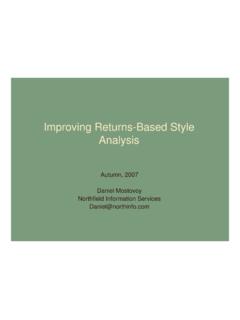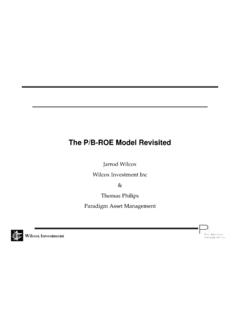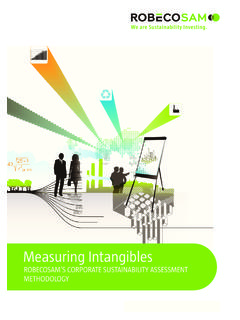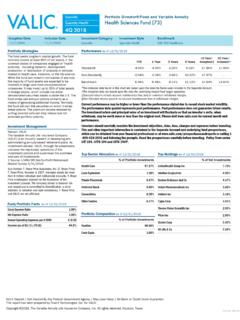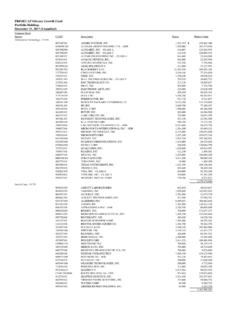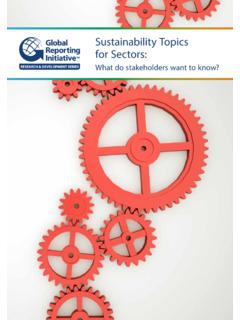Transcription of Custom Hybrid Risk Models - Northfield …
1 Custom Hybrid RISK Models Jason MacQueen Northfield Webinar April 2016 Slide 1 STANDARD RISK Models Off-the-shelf or standard equity risk Models can be used to forecast portfolio risk and tracking error, to show the split between factor risk and stock specific risk, and to show the contributions of each holding to the overall portfolio risk They can also provide a factor risk decomposition of the risk structure of a portfolio based on the particular set of factors used in the risk model However, active fund managers very often use their own (possibly proprietary) factors to do their stock selection and portfolio rebalancing, and these may be very different from the factors in a standard risk model Different definitions, different classifications, different horizon.
2 The only way to produce a portfolio risk analysis expressed in terms of the manager s own factors is to build a customised risk model ( this is not the same thing as a customised version of somebody else s standard model .. ) 1 Slide 2 Custom RISK Models In this presentation, we will review the many different ways in which linear, multi-factor equity risk Models can be constructed to different purposes In particular, we will cover Different types of factors that may be included Different ways in which factors can be constructed The effects of ordering the factors in different ways The effect of adding Statistical factors to a set of Defined factors The effects of time-weighting the historic stock return data and the relationship to the investment horizon of a portfolio The Universe of securities that can be included in a Custom risk model Specialisation & multi-asset class Models 2 Slide 3 CURRENCY FACTORS - 1 Currency risk obviously arises from holding foreign securities, even if they are ADRs or GDRs traded on a domestic exchange However.
3 Currency risk can also come from domestic securities such as Apple or Microsoft, or other multi-national companies Portfolio managers need to decide what to do about these Currency exposures; ignoring them is usually a bad idea! Currency hedging is essentially Currency risk management, so any fund manager who uses Currency Hedging needs to have Currency factors in their risk model to find out how much they need to hedge Some active managers use multi-factor Models to forecast the expected returns to Currencies; in these cases, the Currency forecasting model factors need to be included in the risk model 3 Slide 4 CURRENCY FACTORS - 2 Currency exposures can be treated in several different ways : Using dummy variables as currency betas.
4 This is equivalent to assuming that currency risk is determined by currency of denomination, and also means that the rest of the risk model is all in local currency terms Currency betas derived from time-series regressions will give a better estimate of the true portfolio currency exposures, to avoid over-hedging One way to do this is to allow only priors, meaning that foreign stocks only get a currency beta on their home currency Alternatively, stocks can also be allowed to get secondary currency betas Global risk Models can also be built without any Currency factors at all: in these cases, the stock returns are all in base currency terms, and the fund manager thinks of them and the various markets all in base currency terms 4 Slide 5 STYLE FACTORS - 1 The best portfolio risk forecasts are obtained when factor betas are estimated by regressing stock returns on factor returns (see Scowcroft & Sefton) However, this can only be done when we can reasonably assume that the betas are stable over time.
5 This is true for many factors, such as Currencies, Markets, Countries, Industries and Sectors, but it is not true for Style factors In this case, we must derive the Style betas for each stock, and then estimate the Style factor returns with cross-sectional regressions for each period The resulting Style factor returns will therefore be conditioned on the other factor returns being estimated simultaneously Ideally, we would only estimate a set of Style factors together Some Models estimate all the model factors simultaneously, so the Style factors will be conditioned by the presence of industry factors, for example 5 Slide 6 STYLE FACTORS - 2 One concern fund managers sometimes have is that their Style factor betas may be proprietary However, Style factor betas are nearly always given as normalised z-scores, so if they are given anonymous names, such as M1 to M8, we can build a CHRM including them, without ever knowing what they actually are Managers can also choose how many Style factors to include.
6 We have built Models with 4 or 5 Style factors We have also built a model with over 600 Style factors This arose because the manager believed that their Value factor, for example, behaved differently in different Markets and Industries The danger always that if you fragment Style factors too far, you end up with a factor covariance matrix that can t be used to optimise 6 Slide 7 MARKET or COUNTRY FACTORS - 1 Market factors ( Country factors in a regional or global risk model ) will typically explain the largest part of most stocks variance A single factor Market model has an average R-Squared of 20% to 25% Market or Country factors are typically capitalisation-weighted If we use an index such as the S&P 500, TOPIX or FTSE 100 as a market proxy, the capitalisation weights will vary through time Although this will represent the actual behaviour of the market historically, it may not necessarily give the best portfolio risk forecasts into the future A better alternative is to use current capitalisation weighting.
7 The risk of such a factor will be a much better forecast of the actual risk of the market in the immediate future, as it has the same composition 7 Slide 8 MARKET or COUNTRY FACTORS - 2 In a Global or Regional model , each Country can be used as a separate factor, or they can be grouped together in some way Sometimes this is done because neighbouring Countries each only have very small stock markets; an example would be a Baltic Region factor, consisting of Estonia, Latvia and Lithuania Sometimes a larger Country is paired with a neighbouring small Country, such as Greece & Cyprus, Spain & Portugal, Australia & New Zealand However, it is also possible to build a model with regional factors, such as Europe (with or without the UK!)
8 , the Eurozone, a Nordic Region, and so on The real point is that the factor structure of a Custom risk model should reflect the way the manager thinks about the universe of possible investments There is no right answer ! 8 Slide 9 MARKET or COUNTRY FACTORS - 3 Risk Models should be able to identify SIZE tilts in a portfolio Some Models have SIZE as a Style factor, using some version of normalised/log/square root of market capitalisation as the SIZE beta It is also possible to create a composite SIZE Style beta, including other measures of company SIZE, such as Total Revenues or Book Value Alternatively, Size effects can be captured with a Fama-French-type SIZE factor, such as using SIZE = Russell 2,000 - Russell 1,000 Another alternative, available in Northfield s XRD risk Models .
9 Is to have both a Large Market factor and a Small Market factor In the US XRD model , the US Large Market factor is the top 500 stocks by capitalisation; we then skip the next 500 (think mid-caps) and use the next 2,000 stocks for US Small Market factor 9 Slide 10 SECTOR or INDUSTRY FACTORS - 1 Some Models may have 60+ Industry factors; some may have 20 or so Industry Group factors. Others may have only 8 or 10 Sector factors, and it is also possible to build risk Models which don t have any Industry or Sector factors NB : this is not really a very good idea; the Sector effects don t somehow disappear - they simply show up in the Statistical factors!
10 The point is that a Custom model can use whatever Industry classification scheme the fund manager wants, with as much granularity as desired Note also that the Industry classification may be one of the standard ones (GICS, FTSE, FactSet), or it can be proprietary classification A more recent development has been to create Custom risk Models in which some Industries were treated as Global Industry factors, while others were treated as Country or Regional Industry factors 10 Slide 11 SECTOR or INDUSTRY FACTORS - 2 The only limiting factor is that each Industry or Sector factor has to have enough constituents to make a reasonably well-diversified factor In addition, we sometimes set a maximum weight that any single stock can have in a capitalisation-weighted factor For instance, in the Northfield XRD risk Models , the maximum weight for all Market, Country.



